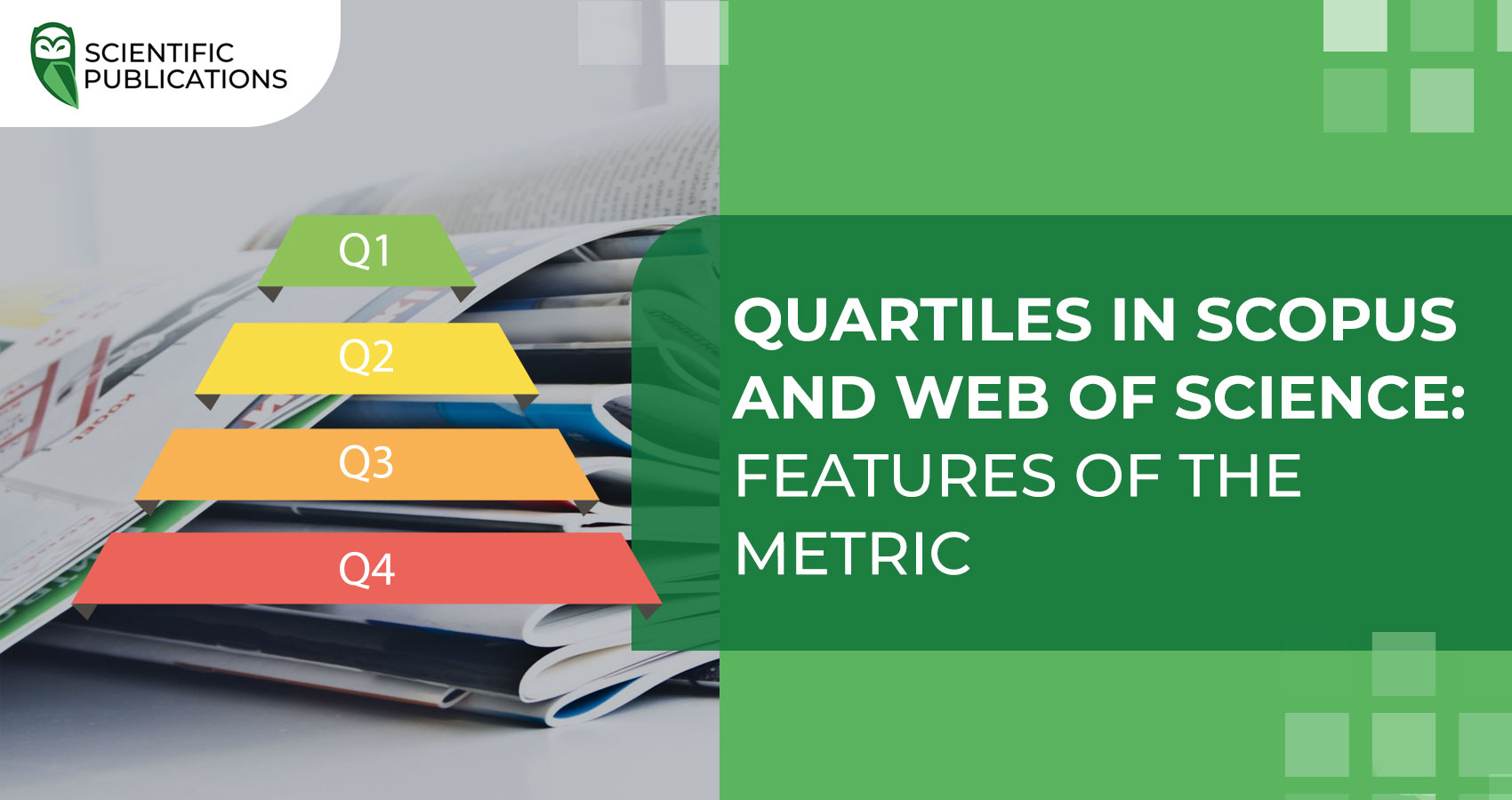Scopus and Web of Science - two leading international databases that are used for the analysis and evaluation of scientific publications. In this article we consider how quartiles are used by Scopus and Web of Science to determine the impact of scholarly journals and articles.

What are quartiles in Scopus and Web of Science?
Quartiles are a metric of the scientometric world and a statistical tool used to divide journal data into four equal parts based on their authority scores. Quartiles are divided into the following categories:
- Q1: the top 25% of the journals with the highest influence rates.
- Q2: publications with high indicators that are in the top 50% in the subject area.
- Q3: good and stable publications for publishing research.
- Q4: mostly young publications or journals with a narrow field of knowledge that have not yet scored high citation rates.
How are quartiles applied in Scopus?
Scopus - the largest cross-disciplinary database indexing more than 25 thousand scientific journals. To determine quartiles, Scopus uses the CiteScore indicator. CiteScore is calculated as the average number of links to articles published in this journal over the past three years. Journals indexed in Scopus are divided into quartiles by CiteScore.
How are quartiles applied in Web of Science?
Web of Science - another well-known international database indexing scientific journals. Instead of CiteScore, Web of Science uses the Journal Impact Factor (JIF) to determine quartiles. JIF is defined as the average number of references to articles published in this journal over the previous two years. Journals indexed in the Web of Science are divided into quartiles by JIF.
Are the quartiles reliable according to the Scimago Journal Rank?
The Scimago Journal Rank (SJR) is one of the scientometric indicators used to assess the impact and quality of scientific journals. As with other indicators such as CiteScore and Journal Impact Factor, SJR-based quartiles are generally considered reliable and are widely used in the academic community.
SJR is based on Scopus data and is a weighted indicator that considers both the number of citations to articles in a journal and the "prestige" of citing journals. It means that references from more authoritative sources carry more weight than references from less authoritative sources. Therefore, it should be remembered that SJR quartiles are "autonomous", although calculated based on Scopus figures. The database itself is guided by the CiteScore quartile score. Therefore, in most cases it should be considered. But there are situations where a scientist needs to publish in Scopus publications with a particular Scimago Journal Rank quartile.
SJR-based quartiles divide scientific journals into four equal groups (Q1, Q2, Q3, Q4) according to their SJR ranking. Journals with a high SJR (Q1) are usually considered the most influential and high-quality in their field.
Can there be multiple quartiles in a log?
Yes, as quartiles are used to classify and rank journals in a specific area. If publications are indexed in several directions at once, their own quartile index is calculated for each of them. But the generally accepted rule for determining the quartile of a journal is to focus on the highest of all defined categories.
In addition, it should be considered that there may be different rating systems and indicators based on different criteria and data. For example, Scopus uses CiteScore, and Web of Science uses Journal Impact Factor. In addition, the Scimago Journal Rank (SJR) is a separate indicator developed based on Scopus data. Each of these systems can define quartiles for logs according to its own criteria.
In this regard, it is possible that the journal may have different quartiles in different rating systems. For example, one journal can be assigned to Q1 in the Scopus rating (CiteScore), but be in Q2 or Q3 by the Journal Impact Factor (Web of Science). It can be due to different methodologies for calculating the indicators and using different input data.
It is therefore important to consider different scientometric indicators and ranking systems when assessing the quality and impact of scholarly journals and choosing the right journal to publish your work.
Can there be no quartile in the log?
Yes, it could be that the journal will not have a particular quartile. It can happen for a variety of reasons:
- A new journal. If a journal is relatively new and has recently been included in the database, it could take some time for it to gather enough publications and citations to receive the appropriate quartile.
- An unindexed journal. Journals that are not indexed in large scientometric databases, such as Scopus or Web of Science, will not have a specific quartile. To receive a quartile, a journal must be included in the relevant database and regularly evaluated scientometrically.
- A specific or understudied field of science. In some cases, journals specialising in a very narrow or understudied field of science may not have a quartile. It can be due to a lack of comparable journals in the field or a low number of publications and citations.
While quartiles are a useful tool to assess the impact and quality of academic journals, it should be remembered that they are not the only criterion. In addition, researchers should consider other factors such as the reputation of the editorial board, the readership of the journal, the quality of peer review and the relevance of the author's specialisation when choosing a suitable journal to publish their work.
Why are quartile scores in Scopus and Web of Science relevant?
Quartiles in Scopus and Web of Science play an important role in the scientometric analysis of scientific publications and journals. They help researchers, scientists, and organisations evaluate the quality and impact of journals, and identify trends and dynamics in the development of various scientific fields.
Understanding the meaning of quartiles can help authors make more informed decisions about which journals to publish their work in. Publication in a journal with a high quartile (Q1 or Q2) is often associated with great influence and recognition in the academic community. However, it should be noted that the competition for publication in such journals may be higher and the peer-review process may take longer.
Therewith, publication in journals with lower quartiles (Q3 and Q4) may be more accessible to younger researchers and authors working in popular or emerging areas of science.
Quartiles are an important scientometric tool that can help researchers and authors determine their research publication strategy and assess the quality and impact of journals. If you need a publication in the rating publications Scopus or Web of Science, contact the specialists of the company Scientific Publications. We will provide full support for your article and help you choose the best journal for publication, considering the main scientometric indicators, including the quartile index!





